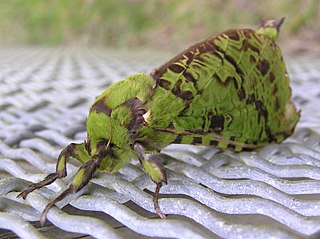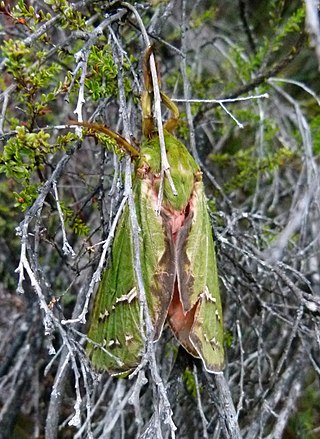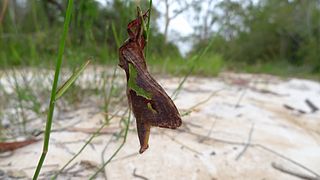
Lantana is a genus of about 150 species of perennial flowering plants in the verbena family, Verbenaceae. They are native to tropical regions of the Americas and Africa but exist as an introduced species in numerous areas, especially in the Australian-Pacific region, South and Northeastern part of India and Bangladesh. The genus includes both herbaceous plants and shrubs growing to 0.5–2 m (1.6–6.6 ft) tall. Their common names are shrub verbenas or lantanas. The generic name originated in Late Latin, where it refers to the unrelated Viburnum lantana.

Alphitonia is a genus of arborescent flowering plants comprising about 20 species, constituting part of the buckthorn family (Rhamnaceae). They occur in tropical regions of Southeast Asia, Oceania and Polynesia. These are large trees or shrubs. In Australia, they are often called "ash trees" or "sarsaparilla trees". This is rather misleading however; among the flowering plants, Alphitonia is not closely related to the true ash trees, and barely at all to the monocot sarsaparilla vines (Smilax).

Eugenia is a genus of flowering plants in the myrtle family Myrtaceae. It has a worldwide, although highly uneven, distribution in tropical and subtropical regions. The bulk of the approximately 1,100 species occur in the New World tropics, especially in the eastern Brazil's northern Andes, the Caribbean, and the Atlantic Forest. Other centers of diversity include New Caledonia and Madagascar. Many species in the Old World have received a new classification into the genus Syzygium.

The Hepialidae are a family of insects in the lepidopteran order. Moths of this family are often referred to as swift moths or ghost moths.

Abantiades is a genus of moths of the family Hepialidae. There are 37 described species, all found exclusively in Australia. The group includes some large species with a wingspan of up to 160 mm. The larvae feed on the roots of Eucalyptus and other trees. Simonsen's 2018 revision of the Australian Hepialidae synonymized the genera Bordaia and Trictena to Abantiades, and included the former genera's species here.

Aenetus is a genus of moths of the family Hepialidae. There are 24 described species found in Indonesia, New Guinea, New Caledonia, Australia and New Zealand. Most species have green or blue forewings and reddish hindwings, but some are predominantly brown or white. The larvae feed in the trunks of living trees, burrowing horizontally into the trunk, then vertically down.

The pūriri moth, also commonly called the ghost moth or pepetuna, is a species of moth of the family Hepialidae. This moth is endemic to the North Island of New Zealand. It is New Zealand's largest moth, with a wingspan of up to 150 mm. It spends the first five to six years of its life as a grub in a tree trunk, with the last 48 hours of its life as a moth. Footage has been taken of a pūriri moth chrysalis hatching over a period of one hour and forty minutes.

Aenetus scripta is a species of moth of the family Hepialidae. It is endemic to south-western Australia.
Aenetus astathes is a moth of the family Hepialidae. It is known from Australia.
Aenetus blackburnii is a moth of the family Hepialidae. It is known from Australia, where it is widely distributed.

Aenetus dulcis is a moth of the family Hepialidae first described by Charles Swinhoe in 1892. It is known from Western Australia.

Aenetus eximia is a moth of the family Hepialidae. It is known from southern Queensland, Australia, to Tasmania.

Aenetus lewinii is a moth of the family Hepialidae. It is known from New South Wales and Queensland.
Aenetus ramsayi, the swift ghost moth, is a moth of the family Hepialidae. It is known from Queensland and New South Wales.
Aenetus splendens is a moth of the family Hepialidae. It is known from New South Wales and Queensland.
Aenetus tegulatus is a moth of the family Hepialidae. It is known from south-eastern Papua New Guinea, the Northern Territory and Queensland.
Aenetus tephroptilus is a moth of the family Hepialidae. It is known from Western Australia.
Abantiades argyrosticha is a species of moth of the family Hepialidae. It was described by Alfred Jefferis Turner in 1929, and is endemic to New South Wales and Queensland.
Metamya aenetus is a moth of the subfamily Arctiinae. It was described by Schaus in 1896. It is found in Paraná, Brazil.










